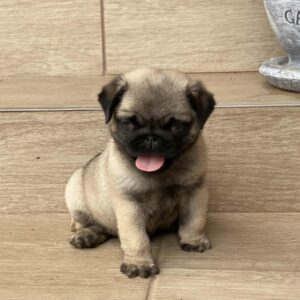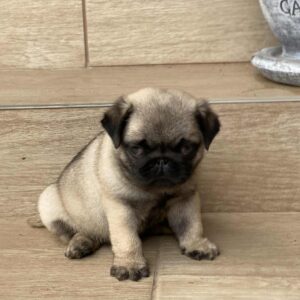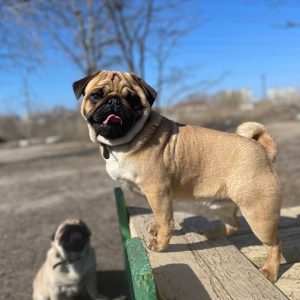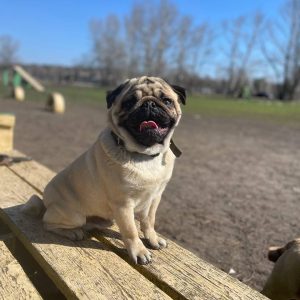
Pug
Stubborn yet sweet-tempered, these little dogs make excellent family pets. Pugs are very easy-going and forgiving, and are a good choice for first time owners. Unfortunately, their short muzzles make them more prone to heat stroke, especially in the hot summer. Keeping them in a cool environment and only walking them in the cooler hours of the day helps to keep pugs healthy.
Pug breed attributes
About Pug breed
Description
Nicknamed the “Mops” and even the “Dutch Mastiff”, the little Pug is a compact dog. They have a stocky, square build, with large round heads. They have a squashy face with a short muzzle and prominent wrinkles. The round eyes are somewhat protruding, with a soft, lustrous appearance. The small silky ears are floppy, and can have a “rose” or “button” shape. The gently arched neck leads down to a short, level back and compact body. The tail curls up over the hip, sometimes in a tight double curl.
Origin: China
Look
The Pug has short glossy fur, with a fine, soft texture. Typical coat colours are fawn, apricot, black and silver. The muzzle and ears should be dark, with a dark line of hair along the back. Pugs are easy to groom but shed heavily. You can brush your Pug regularly to remove any loose hair (a medium length brush or a rubber grooming mitt are very handy), but consider investing in a good lint roller or vacuum cleaner!
Their nails grow fairly quickly and need regular trimming. Many dogs dislike nail trims, but you can train your dog to get used to having their feet handled to make nail trims more bearable.
Health
The Pug breed can suffer from one or more of the following health issues:
- Hip dysplasia
- Hemi-vertebrae
- Patellar luxation
- Legg-Perthes disease
- Corneal ulcers, Dry eye, and other eye problems
- Allergies
- Pug Dog Encephalitis (also called Necrotising Meningo-Encephalitis)
- Epilepsy
- Nerve degeneration
- Brachycephalic Airway Obstructive Syndrome
- Susceptible to mites and mange
- Susceptible to Staph infections
- Susceptible to Yeast infections
At Newdoggy.com, we recommend that you buy your dog from reputable breeders, who use genetic testing and good breeding practices to remove genetic conditions from their breeding lines.
Learning
Pugs are generally sweet and calm, and keen to please their humans. They benefit from early training and socialisation, and do best with firm but fair training methods. Pugs are quite clever and can become bored of repetitive training, and may refuse to cooperate. This tendency has given the Pug a reputation for being stubborn or wilful. The Pug is sensitive and responds poorly to harsh training methods. Pugs sometimes are difficult to housetrain, so consider using crate training.
Temperament
A natural companion breed, Pugs are playful and charming, making them popular family pets. Although these loyal pets do make good watchdogs, they are not yappy or aggressive. A properly socialised Pug will get along with just about everyone, as they tend to be docile and friendly.
A poorly socialised Pug may become obstinate and might start unwanted “guarding” behaviour: do not allow this kind of behaviour to escalate, and seek training advice at once.
Living with
A Pug is an excellent choice if you live in apartment. These small dogs do best living indoors. Pugs do not cope well with hot weather, so make sure you have a fan or air conditioning, and walk them when it’s cooler. They are also not cold resistant, but don’t mind wearing a dog coat or curling up on your lap.
Pugs love to be around people and hate to be left alone for a long time. They get on well with everyone, including children and animals. Although they are mainly indoor dogs, they should be walked at least twice a day. They love to play and run, but you will need to make sure that they don’t over-heat: if your Pug starts wheezing, it’s time to rest.
Find Pug Puppies for Sale
New litter alert
Please fill in the below form and we will let you know when a new Pug litter arrives.






















